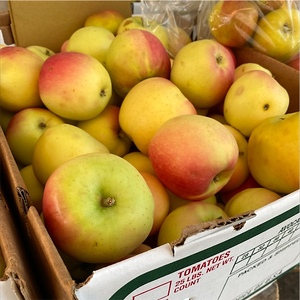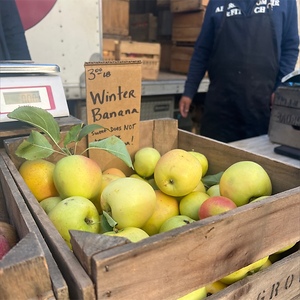


Winter Banana Apple
Estimated Inventory, lb : 0
Description/Taste
Winter Banana apples are large fruits with a somewhat uniform, conical to round shape and are connected by a slender, fibrous brown stem. The skin is waxy, firm, and smooth with a yellow base, covered in patches of pink-red blush from increased sun exposure. Underneath the surface, the flesh is crisp, aqueous, ivory to pale yellow, and semi-coarse, encasing a small central core filled with black-brown seeds. Winter Banana apples have a subtly fruity, tropical scent that is reminiscent of banana or pineapple at peak maturity. The flesh of the fruit also has a mild and balanced, sweet, and tangy flavor.
Seasons/Availability
Winter Banana apples are available in the late fall through early spring.
Current Facts
Winter Banana apples, botanically classified as Malus domestica, are an heirloom variety that belongs to the Rosaceae family. Also known as the Flory apple, Banana apple, and Flory Banana apple, Winter Banana apples are a fresh eating variety created in the 19th century United States and were favored by growers for their flavor, visual appeal, and late-blooming nature. The apple trees are also self-fertile, which has allowed it to become a popular variety used for pollinating other trees in orchards. Winter Banana apples are not commercially favorable due to their easily bruised skin, but it did see some success among apple enthusiasts in England and Germany in the early 20th century. In the modern-day, the variety is primarily cultivated in home gardens and is favored as a rare dessert variety.
Nutritional Value
Winter Banana apples are a good source of vitamins A and C, which are antioxidants that can rebuild collagen within the body and boost the immune system. The apples also provide fiber, which can help regulate digestion, and contain some manganese, calcium, and potassium.
Applications
Winter Banana apples are best suited for raw applications as their sweet-tart flesh is showcased when consumed fresh, out-of-hand. The mild apples are primarily eaten whole as a snack, sliced and served with nuts, cheeses, and other fruits, or chopped and tossed into green salads. Winter Banana apples are also popularly pressed into juice or cider, cooked into applesauce, or used as a subtle flavoring in baked goods. Winter Banana apples pair well with caramel, honey, cheeses such as brie, parmesan, camembert, cheddar, or goat, arugula, blueberries, cantaloupe, pears, and spices such as cinnamon, nutmeg, and cloves. The fresh fruits will keep 1-4 months when stored in a cool, dry, and dark place such as the refrigerator.
Ethnic/Cultural Info
In the mid-20th century, Winter Banana apples were a specialty variety used in fruit baskets for their visual beauty and for their mild, sweet, and tangy flavor. The practice of gifting fruit in baskets has been present in societies since ancient times, but with the invention of cellophane, the fruit basket became a deliverable gift that florists could sell in addition to flowers. Winter Banana apples were considered an unusual cultivar that was eye-catching and exotic, but their appearance still resembled many of the varieties found in commercial markets, creating a sense of familiarity. The fruits were especially popular in England as the variety was difficult to grow in the cold climate, creating exclusivity. Beyond fruit baskets, the variety was so desired by upper-class English families that large boxes of the apples would be sent to estates throughout the country.
Geography/History
Winter Banana apples were first discovered in the orchard of David Flory in Cass County, Indiana, in the mid-1870s. Once selected, the variety was sent to Greening Brothers Nursery in Monroe, Michigan, where it was bred and released to the commercial market in 1890. Winter Banana apples were cultivated on a small scale in British Columbia and Washington and became popular in England and Germany in the early 1900s. Today Winter Banana apples are found through specialty growers at local farmer’s markets and farm stands. The cultivar is also commonly grown in home gardens as a novel, fresh eating apple in the United States, Canada, and Europe.











